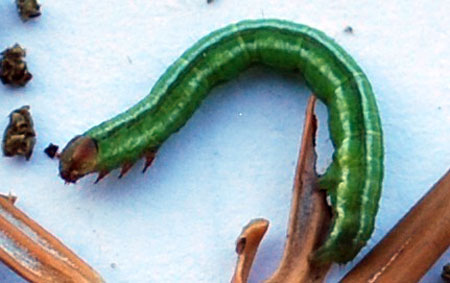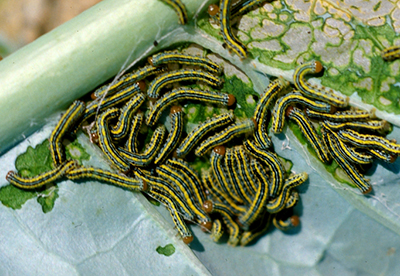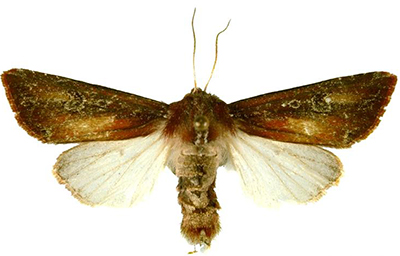Identifying and managing caterpillar pests of the cabbage family
Home gardening strategies for identifying and managing caterpillars that feed on cabbages and their relatives.

During this time of year in many backyard vegetable gardens, members of the cabbage family are growing vigorously, but their leaves are beginning to take on the appearance of lace. Several caterpillars find cabbage, Brussels sprouts, kale, collards, broccoli, cauliflower and related cole crops very appealing.
Identifying caterpillar pests
One of the most common caterpillar pests of the cabbage family is the cabbage butterfly. Cabbageworms are the larvae of cabbage butterflies, a species with white wings that have black margins and black spots. They can be seen fluttering around vegetable gardens where they stop to lay eggs. In three to five days, the eggs hatch into velvety, pale green caterpillars. After feeding for two to three weeks, larvae are full grown and pupate. Younger larvae chew holes in the foliage, leaving the veins behind. Older larvae may keep feeding on leaves or tunnel into heads. There can be four to five generations per year. They overwinter as pupae near their host plants.
Cabbage loopers, a member of the cutworm family, migrate in on storm systems from the south. It is named for its distinctive method of walking, drawing itself up in the manner of inchworms. These loopers have a pale green body with a white side stripe and a few bristles. Cabbage loopers, despite their name, have a broad range of preferred host plants, including potatoes, tomatoes, peas, lettuce, spinach and some ornamentals in addition to cole crops and weedy mustards. They may initially chew only the underside of leaves before making holes through the entire leaf. The adult moth is mottled gray with a distinct silvery spot on each forewings. More extensive information about these pests and an additional caterpillar pest, the diamondback moth, can be found in the Michigan State University Extension Bulletin E3165, “Caterpillar Pests in Cole Crops.”

Cabbage looper larva. Photo by Jill O'Donnell, MSU Extension
Another cutworm relative that prefers to feed on members of the cabbage family is the colorful yet less common zebra caterpillar. It has been recorded on a wide variety of host plants, including a number of vegetables, field crops and ornamentals such as aster, hydrangea and sweetpeas. It has lengthwise yellow, black and white stripes with alternating black and white bands. Young zebra caterpillars like to feed in a group, skeletonizing the lower leaf surface. As they larvae get older, they spread out and feed individually on leaves and flowers. There are normally two generations per year. The adults, which are 1.4-1.6 inches long, are not so colorful; they are chocolate brown with purplish-brown mottling on the forewings, whitish hind wings and a light gray abdomen.

Zebra caterpillar larvae initially like to feed in groups. Photo by Whitney Cranshaw, Colorado State University, Bugwood.org

Adult moth of zebra caterpillar. Photo by Robert J. Baurenfeind, Kansas State University, Bugwood.org
Managing caterpillar damage
Get rid of weedy mustards growing in the vicinity that can serve as host plants. If larvae are small, they can be controlled with a spray of Bt such as Dipel or Thuricide. Hand-picking can be done successfully regardless of size. Caterpillars can be placed in a pail of water with a few drops of detergent to drown.
There are a number of natural enemies that feed on these caterpillars. Parasitic wasps and tachinid flies lay eggs inside the caterpillar that develop and cause the caterpillar’s demise as they use it for a source of food. Lacewings, spider ground beetles and lady beetles are among the predators that feed on eggs or larvae.



 Print
Print Email
Email
